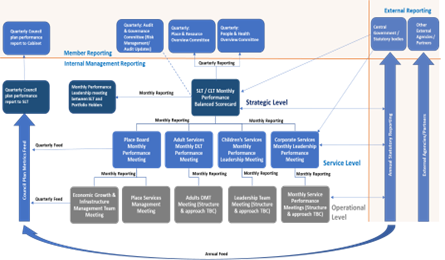Principles of the framework
Effective performance management relies on close monitoring and assessment of a variety of measures from across the council.
These range from the highest-level strategic measures – the council’s key performance indicators (KPIs), through to the multitude of lower level metrics and measures which support individual services and teams.
The framework has four strands of reporting.
Strategic level
Outcomes associated with measuring the successful delivery of the council plan and oversight of the council’s overall performance.
The strategic reporting consists of:
- quarterly reporting on progress with the Dorset Council Plan to the Corporate Leadership Team (CLT) / Senior Leadership Team (SLT) and the Cabinet
- balanced scorecard reporting on service performance: monthly to CLT/ SLT; monthly to performance leadership group (executive directors and portfolio holders); and quarterly to the Place and Resource Overview Committee and the People and Health Overview Committee
- quarterly risk management and internal audit updates to Audit and Governance Committee. The Committee has an assurance role on this overarching framework and will refer any areas of high-level concern to the appropriate overview committee
Service level
Reporting required to make informed service level leadership and management decisions. The approach to service level reporting is in development but will provide monthly management information in a range of formats determined by the senior leadership teams of each of the council’s directorates: People – adults and housing; People – children’s; Place; and Corporate development.
Operational level
Reporting required to successfully oversee and manage the individual operations within services.
Statutory performance (including reporting to agencies and partners)
Returns/reporting which need to be returned to central government as part of the statutory reporting process - this type of information is useful for benchmarking against other authorities operating in statistically similar/comparable populations.
The next sections provide more information about strategic and service level reporting. Service level reporting and operational level reporting is under development and once that work is complete, this document will be updated.

